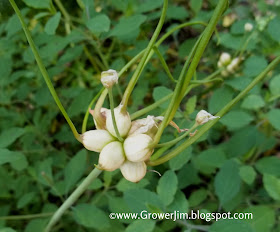Allium canadense is a small species of onion that grows wild over a large part of North America. In some areas it grow so prolifically it is considered a weed. In other areas it is listed as a threatened or endangered species.
These onions never bulb up, instead remaining the size of tiny scallions. The entire plant is edible either raw or cooked. In the kitchen they can be used the same way as conventional green onions.
Foliage is bright green and somewhat stringy in appearance. Leaves are flat in cross-section, not rounded and hollow like many other alliums, and can reach more than a foot in length.
In the warmest parts of its range this species grows during the cooler months and spends the summer in a dormant state. In northern states the growing season is reversed.
In early spring, it appears the plants are getting ready to flower when they send up blue-green stems topped by a large bud, but when the bud opens, mostly what you see is a group of small onion bulbils.
There are only a few white flowers scattered among the pearl-sized onions. Some of these bulbils sprout leaves of their own, forming a miniature plant on top of the stem from the mother plant.
When the plant goes dormant the bulbils dry up, loosen from the stem, and drop to the ground where they wait for the next growing season. It often takes a couple of year for them to reach a harvestable size.
Allium canadense grows in USDA Zones 4-9 in full sun to part shade. Regionally popular common names for this species include wild onion, wild garlic, meadow onion, and meadow garlic.






No comments:
Post a Comment